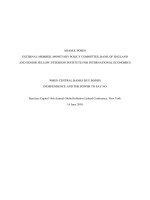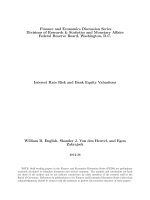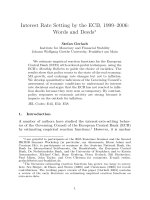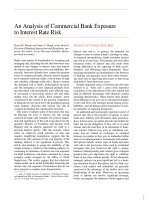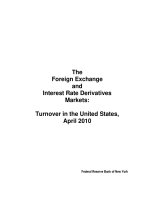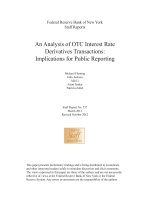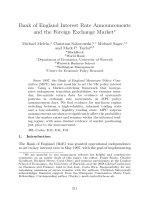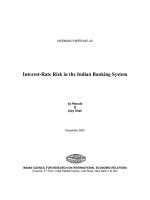Bank of England Interest Rate Announcements and the Foreign Exchange Market ∗ doc
Bạn đang xem bản rút gọn của tài liệu. Xem và tải ngay bản đầy đủ của tài liệu tại đây (445.19 KB, 37 trang )
Bank of England Interest Rate Announcements
and the Foreign Exchange Market
∗
Michael Melvin,
a
Christian Saborowski,
b,c
Michael Sager,
c,e
and Mark P. Taylor
d,f
a
BlackRock
b
World Bank
c
Department of Economics, University of Warwick
d
Warwick Business School
e
Wellington Management
f
Centre for Economic Policy Research
Since 1997, the Bank of England Monetary Policy Com-
mittee (MPC) has met monthly to set the UK policy interest
rate. Using a Markov-switching framework that incorpo-
rates endogenous transition probabilities, we examine intra-
day, five-minute return data for evidence of systematic
patterns in exchange rate movements on MPC policy
announcement days. We find evidence for non-linear regime
switching between a high-volatility, informed trading state
and a low-volatility, liquidity trading state. MPC surprise
announcements are shown to significantly affect the probability
that the market enters and remains within the informed trad-
ing regime, with some limited evidence of market positioning
just prior to the announcement.
JEL Codes: E42, E44, F31.
1. Introduction
The Bank of England (BoE) was granted operational independence
to set its key interest rate in May 1997, with the goal of implementing
∗
We are grateful to two anonymous referees for helpful and constructive
comments on an earlier draft of this paper, the editor, Frank Smets, Charles
Goodhart, Richard Meese, Carol Osler, and seminar participants at the London
School of Economics, the University of Warwick, and the 2008 Global Conference
on Business and Finance, held in San Jose, Costa Rica. Responsibility for any
remaining omissions or errors remains with the authors. Christian Saborowski
acknowledges financial support from the European Commission Marie Curie
Fellowships. Corresponding author (Taylor):
211
212 International Journal of Central Banking September 2010
policy consistent with stable inflation and economic growth.
1
Inter-
est rate decisions are made by the Bank’s Monetary Policy Com-
mittee (MPC), which meets for two days each month—as well as an
additional pre-meeting briefing day—and issues a statement regard-
ing interest rate decisions at noon on the second meeting day. This
framework allows a natural laboratory setting for examining the
impact of monetary policy decisions around a known time and date.
Since market participants know that interest rate announcements
arrive at noon on the second meeting day, there may be positioning
prior to the announcement and news effects after the announcement
that result in systematic differences in the behavior of financial mar-
ket variables on MPC meeting days compared with other, non-MPC
days. In this paper, we concentrate on the pattern of exchange rate
volatility surrounding the MPC’s interest rate decisions as well as
the role played by the surprise content of these announcements.
Although activities directly related to each MPC meeting are
spread over three different days, our empirical analysis will focus
upon the second MPC meeting day, when the policy decision is
made and announced. We use high-frequency, intraday data and a
Markov-switching econometric model where exchange rate returns
switch between a high-volatility, informed trading state and a low-
volatility, uninformed or liquidity trading state. This framework
allows for a characterization of macroeconomic news effects on the
foreign exchange market that differs from the traditional approach.
Thus, we hypothesize that macroeconomic news does not simply
affect the market as shocks to otherwise continuous processes, but
instead may change, temporarily, the entire data-generating process
of exchange rates. One reason is that “hot-potato” trades are likely
to dominate market turnover to an unusual degree around news
events as individual dealers adjust inventory and offload onto others,
effectively generating a multiplier effect on trades (Lyons 1996).
An econometric specification that allows for regime switches
therefore appears appropriate, particularly as it facilitates a plau-
sible interpretation of observed non-linearities. Moreover, and in
contrast to the deterministic models typically employed in similar
1
From the creation of the MPC until July 2006, policy decisions were framed
in terms of the repurchase, or repo, rate and after that date in terms of the Bank
rate. We use the two names interchangeably.
Vol. 6 No. 3 Bank of England Interest Rate Announcements 213
analyses, we allow for a probabilistic and thus flexible characteriza-
tion of the data. In particular, by modeling switching probabilities
endogenously, our approach allows the probability of regime switch-
ing to vary during MPC meeting days. Given the notoriously capri-
cious nature of financial markets, our approach therefore provides an
interesting alternative perspective on the impact of news effects on
asset prices. This is the first important contribution of our research
to the existing empirical literature. The second contribution is the
size of our data set—28,556 high-frequency observations spanning
ten years—which to the best of our knowledge is far longer than
employed by any existing study and is important in ensuring that
our results are robust.
Adopting this approach, we find evidence for non-linear regime
switching between a high-volatility, informed trading state and a
low-volatility, liquidity trading state. MPC surprise announcements
are shown to significantly affect the probability that the market
enters and remains within the informed trading regime, with some
limited evidence of market positioning just prior to the policy
announcement.
The next section provides a brief review of the literature on the
impact of macroeconomic news announcements on financial markets.
In section 3 we provide some background institutional details on the
MPC and the UK monetary-policy-setting process. Section 4 con-
tains a discussion of our econometric methodology and the various
hypotheses to be tested. Section 5 describes our data sets and con-
tains our main empirical findings. Finally, section 6 summarizes our
conclusions and discusses directions for future research.
2. Exchange Rate and Asset-Price Effects of Monetary
Policy Announcements: A Brief Review of the
Literature
Early intraday studies of the impact of macroeconomic news effects
on exchange rates—for instance, Hakkio and Pearce (1985) and Ito
and Roley (1987)—report mixed results in terms of statistical sig-
nificance. This may reflect the coarseness of sampling intervals, with
observations of exchange rates taken at opening, noon, and closing.
If news effects work themselves out within periods less than several
hours, observing the market at three equally spaced points over the
214 International Journal of Central Banking September 2010
trading day will miss much of the action. The increased availability
of high-frequency, intraday foreign exchange rate data considerably
advanced research in this area.
High-frequency, intraday exchange rate volatility effects of news
announcements were first documented by Ederington and Lee (1993,
1995, 1996).
2
Ederington and Lee (1993) use five-minute tick data
from November 1988 to November 1991 for mark-dollar, as well
as various interest rate futures, and define their variable of inter-
est as the deviation of the absolute value of exchange or interest
rate returns in a given five-minute period on day j from the aver-
age return during that period across the whole sample. Ederington
and Lee (1993) regress this variable on a series of dummy variables
that designate the publication schedule of U.S. macroeconomic data
series. They conclude in favor of a significant change in intraday
exchange and interest rate volatility upon publication of various
series, including the monthly employment report, producer price
inflation, and trade data. They find that the standard deviation
of five-minute returns immediately after publication is at least five
times higher on announcement days than on non-announcement,
or control, days. In addition, although the largest volatility impact
occurs within one minute of publication, the standard deviation
of returns remains significantly above normal for up to forty-five
minutes after publication for a number of macroeconomic series.
In an extension to their original paper, Ederington and Lee
(1995) perform a similar analysis using ten-second data, and
conclude that the price reaction to macroeconomic news is largely
completed after only forty seconds. They also find evidence of a
significant change in volatility immediately ahead of key macro-
economic data releases, suggesting that market participants act to
square positions in advance of key event risk. Ahn and Melvin (2007)
also report evidence of switching to a high-volatility, informed trad-
ing state during U.S. Federal Reserve (Fed) policy meetings but prior
to the announcement of decisions. An extensive search of public news
suggests that this informed trading state cannot be explained as the
response to public information, and instead is suggestive of informed
2
Taylor (1987, 1989) provides early high-frequency studies of the foreign
exchange market and finds some evidence of the impact of news on deviations
from covered interest rate parity.
Vol. 6 No. 3 Bank of England Interest Rate Announcements 215
traders taking positions in advance of the meeting conclusion based
upon their expectations of the outcome. This is a theme to which
we return below.
A number of other papers have also found significant evidence of
policy and macroeconomic news effects upon exchange rates, as well
as other asset prices. Goodhart et al. (1993) report the most per-
sistent impact upon exchange rate volatility—four to five days—in
a GARCH-M analysis of U.S. monetary policy announcements and
publication of U.S. trade data. Other studies find the persistence of
news effects to be more fleeting, consistent with Ederington and Lee
(1993). This includes Andersen and Bollerslev (1998) in the context
of a wider study of the determinants of mark-dollar volatility, and
Almeida, Goodhart, and Payne (1998), who find that the volatility
impact of U.S. and German macroeconomic data releases generally
dissipates within fifteen minutes of publication for U.S. data releases
and within approximately three hours for German releases. In addi-
tion, Almeida, Goodhart, and Payne (1998) report that relatively
few German data releases have a significant impact upon exchange
rate volatility, although the number does increase when the authors
account for the proximity of the next Bundesbank policy meeting;
the closer the meeting, the more likely was the Bundesbank to react
to data surprises. Andersen et al. (2003) similarly find that rela-
tively few German data releases exert a statistically significant effect
on exchange rates—in this case, the conditional mean. Their study
also considers the impact of Federal Reserve policy announcements
and various U.S. macroeconomic data series, and finds in favor of
a significant, asymmetric jump effect associated with both types
of news; interestingly, negative U.S. data surprises often exhibit a
larger impact upon exchange rates than positive surprises.
Faust et al. (2003) use intraday, daily, and monthly data from
1994 to 2001 to estimate structural vector autoregressions (SVARs),
incorporating current and future U.S. and foreign short-term inter-
est rates, and exchange rates in order to assess the effect of U.S.
monetary policy shocks on other variables in the SVARs. Although
the results for interest rates are mixed, the impact of policy shocks
upon exchange rates using intraday data is statistically significant.
In a similar vein, Harvey and Huang (2002) examine the impact of
Federal Reserve open-market operations on a range of interest and
exchange rates using GMM estimation and both two-minute and
216 International Journal of Central Banking September 2010
hourly returns, over the sample 1982 to 1988. They find in favor of a
significant increase in intraday interest rate futures volatility associ-
ated with so-called Fed time, but against any significant, generalized
increase in exchange rate return volatility.
3. The Monetary Policy Committee
In May 1997, the UK Chancellor of the Exchequer announced that
the BoE was to be given operational responsibility for setting inter-
est rates via the newly created MPC. The MPC was to focus on
ensuring that inflation was in line with the government-set target of
2.5 percent for the Retail Prices Index excluding mortgage interest
payments “within a reasonable time period without creating undue
instability in the economy.” Although not made explicit, this lan-
guage was widely interpreted as indicating a policy horizon of two
years. The policy goal was subsequently changed to 2.0 percent in
December 2003, and is now defined in terms of the harmonized
consumer price index.
3
Conditional on achieving its inflation tar-
get, the MPC can also address fluctuations in economic growth and
employment.
The MPC meets monthly, normally on the Wednesday and
Thursday following the first Monday of each month. Meeting dates
for each year are made available at the end of the previous year.
4
The timetable for a representative meeting is given in figure 1. On
the Friday morning prior to each meeting, the Committee receives a
briefing from senior BoE staff on important news and data trends.
The monthly MPC meeting typically begins at 15:00 on the fol-
lowing Wednesday afternoon (that is, the first meeting day) with a
review of the state of the UK and world economy. The BoE Chief
Economist starts the meeting with a short summary of any major
events since the Friday briefing. On Thursday morning (the second
meeting day), the MPC reconvenes and the Governor begins with
a summary of the major issues. Members are then invited to state
3
The UK government retains responsibility for establishing the goal of mone-
tary policy. The inflation target is reconfirmed in the government’s annual bud-
get statement. For institutional background on the MPC and the UK monetary
policy process, see Bean (2001) and www.bankofengland.co.uk/monetarypolicy/
framework.htm.
4
These are published at www.bankofengland.co.uk.
Vol. 6 No. 3 Bank of England Interest Rate Announcements 217
Figure 1. Timeline for a Representative Monetary Policy
Committee Meeting
their views on the appropriate policy action. The Deputy Governor
responsible for monetary policy will usually speak first, with the
Governor speaking last. Ultimately, the Governor offers a motion
that he suspects will result in a majority and then calls for a vote,
on the basis of a one-member, one-vote rule. Those in the minority
are asked to state their preferred level of Bank rate. Lastly, the press
statement is developed. If the decision is to change interest rates or
follow a policy that was not expected by the market, the press state-
ment will include the reasons for the action taken. In other cases,
simply the decision is reported. This decision is announced at noon,
London time, and policy is implemented with open-market opera-
tions beginning at 12:15 p.m. on the same day.
4. Methodology
The focus of this paper is on inference regarding movements in the
dollar-sterling exchange rate around the time of the monthly MPC
policy announcement, which occurs at noon on the second meeting
day, as discussed above. As foreign exchange market participants
know in advance when MPC decisions are announced, we exam-
ine five-minute dollar-sterling exchange rate returns for evidence of
changes in market positioning during the meeting and whether such
changes are driven by the news content of the policy announcement.
It is usual to think of high-frequency exchange rate data on
any given day as bounded within a fairly narrow band and exhibit-
ing first-order autocorrelation. By contrast, on MPC meeting days
we may expect important news to be received by the market.
We find it convincing to think of these news effects as changing,
218 International Journal of Central Banking September 2010
temporarily, the entire data-generating process of exchange rates—
and other financial variables—rather than simply introducing a one-
time shock to an otherwise continuous process. Intuitively, so-called
“hot-potato” trades are likely to dominate the market to an unusual
degree in the immediate aftermath of the news as dealers adjust
their inventory and offload onto other dealers, effectively generating
a multiplier effect on trades (Lyons 1996).
An econometric specification allowing for regime switches is
therefore appropriate. We adopt the Markov-switching framework
associated with Hamilton (1990, 1994). An important advantage
of this framework is that it facilitates a plausible interpretation
of observed non-linearities and allows, in our application, for proba-
bilistic rather than deterministic switching between regimes. A
Markov-switching first-order autoregressive model can be written as
Δe
t
= μ(S
t
)+ρ(S
t
)[Δe
t−1
− μ(S
t−1
)] + ε
t
ε
t
∼ N[0,σ
2
(S
t
)], (1)
where Δe
t
is the change in the logarithm of the exchange rate at time
t. The mean of the exchange rate returns process, μ, the autocorrela-
tion coefficient, ρ, and the variance of the innovation, ε
t
, are allowed
to take on one of two values depending on the realization of an
unobserved state variable S
t
∈{1, 2}. In our application, we assume
a two-state Markov process. One of the states (say, state 2) may be
thought of as reflecting the usual pattern of exchange rate returns
with negative autocorrelation and a relatively small variance. This
tranquil state is associated with liquidity trading when no important
information arrives in the market. The other state (state 1) may be
thought of as the informed trading state when volatility is high and
realized returns much larger than normal (Easley and O’Hara 1992;
Lyons 2001).
Thus far, our proposed methodology is similar to that employed,
inter alia, in Engel and Hamilton (1990). However, we diverge from
the traditional Markov approach by modeling the probability of
switching from one regime to another endogenously. Denoting the
transition probability of switching from regime j to regime i at time
t as P
ij
t
for i, j ∈{1, 2}, we can write the postulated functions for
the transition probabilities, conditional upon information at time t,
I
t
, and the previous state, as
Vol. 6 No. 3 Bank of England Interest Rate Announcements 219
P
ii
t
= Pr[S
t
= i|S
t−1
= i, I
t
]=Φ
α
ii
+ β
ii
X
t
(2)
for i ∈{1, 2}, where Φ[ ] denotes the cumulative normal density
function (in order to ensure that the probabilities lie in the unit
interval) and where X
t
∈ I
t
is a vector of variables known at time
t which may influence the transition probability according to the
vector of loadings β
i
. Given P
11
t
, we implicitly have P
21
t
=1− P
11
t
;
similarly, given an estimate of P
22
t
, we implicitly have P
12
t
=1−P
22
t
.
The Markov-switching framework is applied to our data set to
address several questions of interest. First, can we identify endoge-
nous regime switching? Second, are the transition probabilities driv-
en by the news component in the policy announcements? To test
if the MPC policy announcement is price-relevant public news, we
incorporate various dummy variables into the explanatory variable
vector X
t
. These dummies are set equal to one for a certain after-
noon period on the second MPC meeting day, say noon to 13:00,
and to zero otherwise. Third, is there evidence of positioning during
the second meeting day prior to the noon policy announcement? To
address this question, we incorporate dummy variables set equal to
one for various time intervals prior to noon and zero otherwise.
5. Data and Empirical Findings
5
Our data sample spans more than a decade, running from the incep-
tion of the MPC in June 1997 through October 2007, and incor-
porates 126 MPC meetings. Table 1 lists the MPC meeting days
in our sample and the associated interest rate decisions. We clas-
sify an MPC decision as a surprise to the market if it differs from
the median expectation taken from a Bloomberg survey of market
economists.
6
The standard deviation of analysts’ expectations is
reported as a measure of forecast dispersion. Table 1 also provides
5
Unless otherwise stated, all references to MPC meeting days relate to second
meeting days, when the policy announcement is made.
6
This survey is carried out on the Friday before each MPC meeting and asks
respondents for the magnitude—if any—of the interest rate change that they
expect to result from the upcoming meeting. In its current guise, the survey col-
lates the expectations of up to sixty financial economists. Although the sample of
economists is not necessarily the same from one month to the next, a core subset
ensures continuity.
220 International Journal of Central Banking September 2010
Table 1. Monetary Policy Committee Meetings, Interest Rate Decisions,
and Surprise Measures
The table contains interest rate decisions of the MPC for the period June 1997–October 2007. “Bloomberg Expectation” refers to
the interest rate change predicted by the median expectation in a Bloomberg survey of market economists. “Forecast Dispersion” is
the standard deviation calculated from individual analysts’ forecasts. The final five columns in the table indicate whether the interest
rate announcement surprised the market according to the respective measure. The variable “IB10” (“IB15”) indicates whether the
change in the three-month interbank rate from one day before the announcement to one day after the announcement was greater or
equal to 10 (15) basis points. “LIFFE10” and “LIFFE15” are defined similarly but based on sterling three-month interest rate futures
contracts.
Interest Rate Bloomberg Forecast Bloomberg IB10 IB15 LIFFE10 LIFFE15
Date
Decision Expectation Dispersion
Surprise Surprise Surprise
Surprise Surprise
6-Jun-97 6.5
6.25 Missing Yes No
No No No
10-Jul-97 6.75
6.75 Missing No
No No No No
7-Aug-97 7 6.75 Missing Yes No No No No
11-Sep-97 7
7
Missing No
Yes No
No
No
9-Oct-97 7 7 Missing No No No No No
6-Nov-97 7.25 7 Missing Yes No No Yes Yes
4-Dec-97 7.25 7.25 Missing No No No No No
8-Jan-98 7.25 7.25 Missing No No No No No
5-Feb-98 7.25
7.25 Missing No No No No No
5-Mar-98
7.25 7.25
Missing No No No No No
9-Apr-98
7.25
7.25 Missing
No Yes
No No No
7-May-98 7.25
7.25
Missing No
No No
No No
4-Jun-98 7.5 7.25 Missing Yes Yes Yes Yes Yes
9-Jul-98 7.5 7.5 Missing No Yes No Yes No
6-Aug-98
7.5 7.5 Missing No No No No No
10-Sep-98 7.5
7.5 Missing No Yes No No No
(continued)
Vol. 6 No. 3 Bank of England Interest Rate Announcements 221
Table 1. (Continued)
Interest Rate Bloomberg Forecast Bloomberg IB10 IB15 LIFFE10 LIFFE15
Date Decision Expectation Dispersion Surprise Surprise Surprise Surprise Surprise
8-Oct-98 7.25 7.5 0.127 Yes Yes Yes Yes Yes
5-Nov-98 6.75 7 0.059 Yes Yes No No No
10-Dec-98 6.25 6.5 0.145 Yes No No No No
7-Jan-99 6 6.25 0.000 Yes Yes Yes No No
4-Feb-99 5.5 5.75 0.128 Yes Yes Yes Yes Yes
3-Mar-99 5.5 5.25 0.128 No No No Yes No
8-Apr-99 5.25 5.25 0.079 No No No No No
6-May-99 5.25 5.25 0.107 No No No No No
10-Jun-99 5 5.25 0.109 Yes Yes No Yes No
8-Jul-99 5 5 0.000 No No No No No
5-Aug-99 5 5 0.000 No No No No No
8-Sep-99 5.25 5 0.000 Yes Yes Yes Yes Yes
7-Oct-99
5.25 5.25 0.101 No Yes No Yes No
4-Nov-99 5.5 5.5 0.106 No Yes Yes Yes Yes
9-Dec-99 5.5 5.5 0.056 No No No No No
13-Jan-00
5.75 5.75 Missing No No No No No
10-Feb-00 6 6 0.074 No No No No No
9-Mar-00 6 6 0.086 No No No No No
6-Apr-00 6 6 0.127 No No No No No
4-May-00
6 6.25 0.000 Yes No No No No
7-Jun-00
6 6 0.072 No No No No No
6-Jul-00 6 6 0.115 No No No No No
(continued)
222 International Journal of Central Banking September 2010
Table 1. (Continued)
Interest Rate
Bloomberg Forecast Bloomberg IB10 IB15 LIFFE10 LIFFE15
Date Decision Expectation Dispersion Surprise Surprise Surprise Surprise Surprise
3-Aug-00 6 6 0.101 No No No No No
7-Sep-00 6 6 0.067 No No No No No
5-Oct-00 6 6
0.000 No No No No No
9-Nov-00 6 6
0.000 No No
No No No
7-Dec-00 6 6 0.394 No No No No No
11-Jan-01 6 6 0.083 No No No No No
8-Feb-01
5.75 5.75 0.067
No No No
No No
8-Mar-01 5.75 5.75 0.125
No No No
No No
5-Apr-01 5.5 5.5 0.049 No No No No No
10-May-01 5.25 5.25 0.000 No No No No No
6-Jun-01 5.25 5.25 Missing No No No No No
5-Jul-01 5.25
5.25 0.000
No No No Yes No
2-Aug-01
5 5.25
0.000 Yes
Yes
Yes Yes Yes
6-Sep-01
5 5
0.131
No No
No
No No
18-Sep-01 4.75 Missing 0.111 Yes Yes No No No
4-Oct-01 4.5 4.5 0.096 No No No No No
8-Nov-01 4 4.25 0.000 Yes Yes Yes Yes No
5-Dec-01 4 4 0.000 No No No Yes No
10-Jan-02 4 4 0.069 No No No No No
7-Feb-02
4 4
0.000 No
No No No No
7-Mar-02 4 4 0.000 No No No No No
4-Apr-02 4 4 0.000 No No No No No
(continued)
Vol. 6 No. 3 Bank of England Interest Rate Announcements 223
Table 1. (Continued)
Interest Rate Bloomberg Forecast Bloomberg IB10 IB15 LIFFE10 LIFFE15
Date Decision Expectation Dispersion Surprise Surprise Surprise Surprise Surprise
9-May-02 4 4 0.073 No No No No No
6-Jun-02 4 4 0.045 No No No No No
4-Jul-02 4 4 0.000 No No No No No
1-Aug-02 4 4 0.000 No No No No No
5-Sep-02 4 4 0.071 No No No No No
10-Oct-02 4 4 0.127 No No No Yes No
7-Nov-02 4 4 0.000 No No No No No
5-Dec-02 4 4 0.000 No No No No No
9-Jan-03 4 4 0.046 No No No No No
6-Feb-03 3.75 4 0.000 Yes Yes Yes Yes Yes
6-Mar-03 3.75 3.75 0.080 No No No No No
10-Apr-03 3.75 3.75 0.126 No No No No No
8-May-03
3.75 3.75 0.097 No No No No No
5-Jun-03 3.75 3.75 0.107 No No No No No
10-Jul-03 3.5 3.75 0.000 Yes Yes Yes No No
7-Aug-03
3.5 3.5 0.000 No No No No No
4-Sep-03 3.5 3.5 0.000 No No No No No
9-Oct-03 3.5 3.5 0.037 No Yes Yes No No
6-Nov-03 3.75 3.75 0.039 No No No No No
9-Dec-03
3.75 3.75 0.041 No No No No No
8-Jan-04
3.75 3.75 0.041 No No No No No
5-Feb-04 4 4 0.000 No No No No No
(continued)
224 International Journal of Central Banking September 2010
Table 1. (Continued)
Interest Rate
Bloomberg Forecast Bloomberg IB10 IB15 LIFFE10 LIFFE15
Date Decision Expectation Dispersion Surprise Surprise Surprise Surprise Surprise
4-Mar-04 4 4 0.124 No No No No No
8-Apr-04 4 4 0.053 No No No No No
6-May-04 4.25 4.25
0.126 No No No No No
10-Jun-04 4.5 4.5
0.055 No No
No No No
8-Jul-04 4.5 4.5 0.000 No No No No No
5-Aug-04 4.75 4.75 0.038 No No No No No
9-Sep-04
4.75 4.75 0.000
No No No
No No
7-Oct-04 4.75 4.75 0.053
No No No
No No
4-Nov-04 4.75 4.75 0.000 No No No No No
9-Dec-04 4.75 4.75 0.000 No No No No No
12-Jan-05 4.75 4.75 0.000 No No No No No
10-Feb-05 4.75
4.75 0.000
No No No No No
10-Mar-05
4.75 4.75
0.000 No
No
No No No
7-Apr-05
4.75 4.75
0.042
No No
No
No No
9-May-05 4.75 4.75 0.000 No No No No No
9-Jun-05 4.75 4.75 0.065 No No No No No
7-Jul-05 4.75 4.75 0.084 No No No Yes No
4-Aug-05 4.5 4.5 0.000 No No No No No
8-Sep-05 4.5 4.5 0.000 No No No No No
6-Oct-05
4.5 4.5
0.000 No
No No No No
10-Nov-05 4.5 4.5 0.000 No No No No No
8-Dec-05 4.5 4.5 0.000 No No No No No
(continued)
Vol. 6 No. 3 Bank of England Interest Rate Announcements 225
Table 1. (Continued)
Interest Rate
Bloomberg Forecast Bloomberg IB10 IB15 LIFFE10 LIFFE15
Date Decision Expectation Dispersion Surprise Surprise Surprise Surprise Surprise
12-Jan-06 4.5 4.5 0.000 No No No No No
9-Feb-06 4.5 4.5 0.000 No No No No No
9-Mar-06 4.5 4.5 0.000 No No No No No
6-Apr-06 4.5 4.5 0.000 No No No No No
4-May-06 4.5 4.5 0.000 No No No No No
8-Jun-06 4.5
4.5 0.000 No No No No No
6-Jul-06 4.5 4.5 0.096 No No No No No
3-Aug-06 4.75 4.5 0.000 Yes Yes Yes Yes Yes
7-Sep-06 4.75 4.75 0.000 No No No No No
5-Oct-06
4.75 4.75 0.000 No No No No No
9-Nov-06 5 5 0.000 No No No No No
7-Dec-06 5 5 0.000 No No No No No
11-Jan-07 5.25 5 0.093 Yes Yes Yes Yes Yes
8-Feb-07 5.25 5.25 0.085 No No No No No
8-Mar-07 5.25 5.25 0.086 No No No No No
5-Apr-07 5.25 5.25 0.000 No No No No No
10-May-07 5.5 5.5 0.062 No No No No No
7-Jun-07 5.5 5.5 0.081 No No No No No
5-Jul-07 5.75 5.75 0.000 No No No No No
2-Aug-07
5.75 5.75 0.000 No No No No No
6-Sep-07 5.75 5.75 0.032 No No No No No
4-Oct-07 5.75 5.75 0.055 No No No No No
Source: Bank of England, Bloomberg, and DataStream.
226 International Journal of Central Banking September 2010
two alternative surprise measures—based on three-month interbank
interest rates (IB) and three-month sterling interest rate futures
contracts traded on the London International Financial Futures
Exchange (LIFFE)—to be used for robustness checks.
7
Table 1 suggests that the Bank of England has succeeded in
achieving its goal of improving monetary policy transparency (King
2000). All measures of market expectations show a clear trend lower
in the frequency of policy surprises. The Bank rate was changed
on thirty-six occasions during our sample: raised at nineteen meet-
ings and lowered at seventeen meetings. One-half of these instances
were fully expected by the market, as measured by the Bloomberg
survey. For the other eighteen instances, the market was either sur-
prised that the MPC changed the policy rate or was surprised by
the extent of the change. There were no instances where the market
expected a change in the policy rate in the opposite direction to
the change actually announced, although in May 2000 the market
expected a change whereas the MPC kept the Bank rate constant.
Overall, therefore, we observe nineteen policy surprises during our
sample according to the Bloomberg survey.
8
Consequently, we sepa-
rate our sample of 126 second MPC meeting days into two parts: (i)
the 107 second meeting days when the change in the policy rate—
including a change of 0 basis points—was in line with expectations
(we term these “No Unexpected Change” days) and (ii) the nineteen
days when the announced rate changed by an amount different to
market expectations (we term these “Unexpected Change” days).
Tick data for the dollar-sterling exchange rate were obtained
from a major international bank for each of our 126 MPC meeting
days and a set of 126 control days, defined as the same day of the
week as the MPC meeting seven days later. Insufficient exchange
rate data were available for 14 out of the total of 252 days.
9
7
The period t policy announcement is classified as a surprise to the market if
the difference between the rate in periods t + 1 (interbank or LIFFE) and t − 1
is greater than 10 (15) basis points, where t is the second MPC meeting day and
the interest rate data are sampled daily.
8
According to “IB10” (“IB15,” “LIFFE10,” “LIFFE15”), twenty-one (thir-
teen, nineteen, ten) policy surprises can be identified during the sample period.
9
We also do not include the extraordinary, unscheduled meeting of September
18, 2001, and the respective control day on September 25, 2001.
Vol. 6 No. 3 Bank of England Interest Rate Announcements 227
We sample the last quotation of each five-minute interval over
the hours 7:00–17:00 London time to create a series of exchange rate
returns, defined as the change in the logarithm of the five-minute
observations multiplied by 10,000.
10
By way of example, the 12:05
observation on any given day is the last quotation from within the
interval 12:00–12:05. The data for each day are stacked in serial order
to create a data set with 28,556 observations.
The Markov model represented by the set of equations (1) above
is used to estimate the effect of MPC announcements on the tran-
sition probabilities. Estimation of the model is carried out using a
modified version of the EM algorithm due to Diebold, Lee, and Wein-
bach (1994). The two states are identified by significant shifts in the
mean μ, the autocorrelation coefficient ρ, and the variance σ
2
. Recall
that state 1 is the high-variance state associated with information-
based trading and state 2 is the low-variance state associated with
the normal market conditions of liquidity trading. Consistent with
these definitions, the results in table 2 show that the estimated state
1 variance, σ
2
(1), is generally found to be about 3.5 times that of
state 2, σ
2
(2). Statistically significant negative first-order autocor-
relation, a common feature of high-frequency exchange rate returns,
is also apparent.
In table 2, panel A we report estimates of the (restricted)
constant transition probability model, and in panel B the (unre-
stricted and preferred) time-varying transition probability model.
The reported likelihood-ratio statistic is statistically significant and
justifies our decision to estimate the transition probabilities endoge-
nously.
11
The transition probabilities estimated by the restricted
model are reported in table 2; P
11
is the probability of remaining in
10
Danielsson and Payne (2002) compare one week of indicative quote data
with firm quotes from an electronic FX brokerage and find that the properties of
returns for each series become quite similar at a five-minute sampling frequency.
At higher frequencies, the indicative quotes tend to lag firm quotes. We there-
fore choose five-minute sampling to ensure that our exchange rate returns are
representative of market conditions. The raw data were referenced to Greenwich
Mean Time (GMT), so time references were appropriately adjusted to account for
British Summer Time.
11
From the log-likelihood values reported in table 2, this statistic is
−2(−73022 + 71082) = 3880 (p-value = 0.00). Note that the means are not sig-
nificantly different from zero in the specification with constant transition proba-
bilities. This is the only specification for which this is the case.
228 International Journal of Central Banking September 2010
Table 2. Markov-Switching Model of MPC News and News Anticipation Effects
The table reports estimates of a Markov-switching model for dollar-sterling exchange rate returns sampled at a frequency of five
minutes over the London business day. The final, preferred specification was a first-order autoregression in returns with a regime-
switching variance, a regime-switching mean, and a regime-switching autocorrelation coefficient. Transition probabilities are modeled
as switching endogenously as a function of MPC-related events as in the following equation (where Φ denotes the cumulative normal
density function):
P
11
=Φ(α
11
+Σ
k
β
11,k
dum
k
) and P
22
=Φ(α
22
+Σ
k
β
22,k
dum
k
).
A. Constant Transition Probability Model
Coefficient Estimates (p-values)
ρ(1) −0.13 (0.000)
σ
2
(1) 5.51 (0.000)
ρ(2) −0.15 (0.000) σ
2
(2) 1.61 (0.000)
Constant
P
11
1.68 (0.000)
P
22
1.74 (0.000)
LogL = −73022
B. Preferred Time-Varying Transition Probability Model
B1. Surprise Measure Based on Bloomberg Survey of Market Economists
Coefficient Estimates (p-values) of Regime-Switching AR(1) Model
μ(1) 0.44 (0.000)
ρ(1) −0.12 (0.000)
σ
2
(1) 6.11 (0.000)
μ(2) −0.28 (0.000) ρ(2) −0.11 (0.000) σ
2
(2) 1.64 (0.000)
Coefficient Estimates (p-values) for Endogenous Transition Probabilities
Constant
Dummy 1
Dummy 2 Dummy 3 Dummy 4 Dummy 5
Type of Day Unexp. Ch. All MPC All Days All MPC All MPC
Time 12:05–13:00 12:05–13:00 12:05–13:45 11:30–11:55 11:15–11:55
P
11
0.74 (0.000) 0.96 (0.000) 0.31 (0.000) −0.01(0.000) 0.31 (0.019)
P
22
7.15 (0.000) −2.34 (0.000) −0.87 (0.002)
LogL = −71082
(continued)
Vol. 6 No. 3 Bank of England Interest Rate Announcements 229
Table 2. (Continued)
B2. Surprise if Change in Three-Month Interbank Rate Is Greater Than 10 Basis Points
Coefficient Estimates (p-values) of Regime-Switching AR(1) Model
μ(1) 0.44 (0.000) ρ(1) −0.12 (0.000) σ
2
(1) 6.11 (0.000)
μ(2) −0.29 (0.000) ρ(2) −0.11 (0.000) σ
2
(2) 1.64 (0.000)
Coefficient Estimates (p-values) for Endogenous Transition Probabilities
Constant Dummy 1 Dummy 2 Dummy 3 Dummy 4 Dummy 5
Type of Day Unexp. Ch. All MPC All Days All MPC All MPC
Time 12:05–13:00 12:05–13:00 12:05–13:45 11:30–11:55 11:15–11:55
P
11
0.74 (0.000) 0.86 (0.000) 0.33 (0.000) −0.01 (0.000) 0.31 (0.019)
P
22
7.15 (0.000) −2.34 (0.000) −0.87 (0.003)
LogL = −71084
B3. Surprise if Change in Three-Month Interbank Rate Is Greater Than 15 Basis Points
Coefficient Estimates (p-values) of Regime-Switching AR(1) Model
μ(1) 0.44 (0.000)
ρ(1) −0.12 (0.000) σ
2
(1) 6.11 (0.000)
μ(2) −0.28 (0.000) ρ(2) −0.11 (0.000) σ
2
(2) 1.64 (0.000)
Coefficient Estimates (p-values) for Endogenous Transition Probabilities
Constant Dummy 1 Dummy 2 Dummy 3 Dummy 4 Dummy 5
Type of Day Unexp. Ch. All MPC All Days All MPC All MPC
Time 12:05–13:00 12:05–13:00 12:05–13:45 11:30–11:55 11:15–11:55
P
11
0.74 (0.000) 0.51 (0.061) 0.43 (0.000) –0.01 (0.000) 0.31 (0.019)
P
22
7.14 (0.000) –2.34 (0.000) –0.86 (0.001)
LogL = −71082
(continued)
230 International Journal of Central Banking September 2010
Table 2. (Continued)
B4. Surprise if Change in Price of Three-Month Interest Rate Futures Is Greater Than 10 Basis Points
Coefficient Estimates (p-values) of Regime-Switching AR(1) Model
μ(1) 0.44 (0.000) ρ(1) −0.12 (0.000) σ
2
(1) 6.11 (0.000)
μ(2) −0.28 (0.000)
ρ(2) −0.11 (0.000) σ
2
(2) 1.64 (0.000)
Coefficient Estimates (p-values) for Endogenous Transition Probabilities
Constant Dummy 1 Dummy 2 Dummy 3 Dummy 4 Dummy 5
Type of Day Unexp. Ch. All MPC All Days All MPC All MPC
Time 12:05–13:00
12:05–13:00 12:05–13:45 11:30–11:55
11:15–11:55
P
11
0.74 (0.000) 0.62 (0.011) 0.39 (0.000) −0.01 (0.000) 0.31 (0.019)
P
22
7.15 (0.000) −2.34 (0.000) −0.87 (0.000)
LogL = −71082
B5. Surprise if Change in Three-Month Interest Rate Futures Is Greater Than 15 Basis Points
Coefficient Estimates (p-values) of Regime-Switching AR(1) Model
μ(1) 0.44 (0.000) ρ(1) −0.12 (0.000) σ
2
(1) 6.11 (0.000)
μ(2) −0.28 (0.000) ρ(2) −0.11 (0.000)
σ
2
(2) 1.64 (0.000)
Coefficient Estimates (p-values) for Endogenous Transition Probabilities
Constant Dummy 1 Dummy 2 Dummy 3 Dummy 4 Dummy 5
Type of Day
Unexp. Ch. All MPC All Days All MPC All MPC
Time
12:05–13:00 12:05–13:00 12:05–13:45 11:30–11:55 11:15–11:55
P
11
0.74 (0.000) 0.67 (0.048) 0.44 (0.000) −0.01 (0.000) 0.30 (0.020)
P
22
7.15 (0.000) −2.34 (0.000) −0.87 (0.001)
Vol. 6 No. 3 Bank of England Interest Rate Announcements 231
the high-volatility state and P
22
is the probability of remaining in
the low-volatility state. Normally, we would expect P
22
>P
11
and,
from table 2, this is what the data reveal. Estimating a Markov-
switching model with fixed transition probabilities results in the fol-
lowing estimates: P
11
= Φ(1.68)=0.95 and P
22
= Φ(1.74)=0.96.
The unconditional probability of being in state 2 associated with
these transition probabilities is given as
(1−P
11
)
(1−P
11
)+(1−P
22
)
=0.556,
and the unconditional probability of being in state 1 is 0.444.
Moving to the time-varying probabilities model (table 2, panel
B), it is first interesting to find that the mean return is significantly
positive in the high-volatility state and significantly negative in the
low-volatility state. This result might appear puzzling, as it suggests
that return volatility is high when the pound appreciates against the
dollar and low when it depreciates. Consequently, it is interesting to
investigate whether this result is driven by MPC announcements or
is simply an artifact of the data in the sample period considered.
To consider this issue, we include additional intercept terms into
the mean equation of our preferred specification:
Δe
t
= μ(S
t
)+μ
pos
(S
t
)I(Δi>0) + μ
neg
(S
t
)I(Δi<0)
+ ρ(S
t
)[Δe
t−1
− μ(S
t−1
)] + ε
t
, (3)
where μ
pos
and μ
neg
are additional constant terms, I(Δi>0) is an
indicator function that takes the value of one on Unexpected Change
days between 12:05 and 13:00 if the announced interest rate is higher
than expected, and I(Δi<0) is an indicator function that takes the
value of one on Unexpected Change days between 12:05 and 13:00
if the announced interest rate is lower than expected.
12
As table 3 reveals, the coefficients on μ
pos
are significantly pos-
itive in both states and the coefficients on μ
neg
significantly nega-
tive. These results indicate, as expected, that a higher UK policy
rate than expected yields a positive mean return to holding ster-
ling during the main impact period of the announcement, imply-
ing that the pound appreciates. A lower policy rate than expected
yields a negative mean return during the main impact period of
12
We select this definition for the indicator function, as our analysis below will
demonstrate that the impact of interest rate announcements on the market is
largest between 12:05 and 13:00 on Unexpected Change days.
232 International Journal of Central Banking September 2010
Table 3. Markov-Switching Model Including Additional Constant Terms
The table reports estimates from the preferred specification (table 2, panel B) augmented to include additional constant
terms in the mean equation. The mean equation is now defined as Δe
t
= μ(S
t
)+(S
t
)I(Δi>0) + μ
neg
(S
t
)I(Δi<0) +
ρ(S
t
)[Δe
t−1
− μ(S
t−1
)] + ε
t
, where μ
pos
and μ
neg
are additional constant terms, I(Δi>0) is an indicator function that takes
the value of one on interest rate surprise days between 12:05 and 13:00 if the announced interest rate is higher than expected, and
I(Δi<0) is an indicator function that takes the value of one on interest rate surprise days between 12:05 and 13:00 if the announced
interest rate is lower than expected.
Coefficient Estimates (p-values) of Regime-Switching AR(1) Model
μ(1) 0.43 (0.000) ρ(1) −0.13 (0.000)
σ
2
(1) 6.09 (0.000)
μ(2) −0.28 (0.000)
ρ(2) −0.11 (0.000) σ
2
(2) 1.64 (0.000)
μ
pos
(1) 3.27 (0.000) μ
neg
(1) −0.98 (0.093)
μ
pos
(2) 0.53 (0.047)
μ
neg
(2) −2.54 (0.000)
Coefficient Estimates (p-values) for Endogenous Transition Probabilities
Constant Dummy 1
Dummy 2 Dummy 3
Dummy 4 Dummy 5
Type of Day
Unexp. Ch. All MPC
All Days All MPC All MPC
Time
12:05–13:00
12:05–13:00
12:05–13:45 11:30–11:55
11:15–11:55
P
11
0.75 (0.000) 0.86 (0.000)
0.31 (0.000) −0.01 (0.000)
0.30 (0.031)
P
22
7.24 (0.000) −2.37 (0.000) −0.89 (0.008)
LogL = −71064.25
Vol. 6 No. 3 Bank of England Interest Rate Announcements 233
the announcement, implying that the pound depreciates. Despite
inclusion of these control dummies, however, none of our previous
results are changed in any significant way. This indicates that our
original finding is a general characteristic of the data during our
sample, rather than a function of surprise policy announcements.
Periods when the pound appreciates against the dollar tend to be
more volatile than periods when the pound depreciates.
Returning to the core focus of our investigation, and table 2,
panel B, transition probabilities in our preferred specification are
modeled as varying with dummy variables that equal one at desig-
nated times of day and zero otherwise. Preliminary estimates suggest
that the preferred model expresses P
11
as a function of a constant, a
dummy equal to one from 12:05 to 13:00 only on Unexpected Change
days, a dummy equal to one from 12:05 to 13:00 on All MPC days,
a dummy equal to one on All days between 12:05 and 13:45, and a
dummy equal to one between 11:30 and 11:55 on All MPC days.
13
P
22
is a function of a constant, a dummy equal to one on All days
between 12:05 and 13:45, and a dummy equal to one on All MPC
meeting days from 11:15 to 11:55. All estimated coefficients differ
significantly from zero with p-values of 0.02 or lower.
The results indicate that the probability of remaining in the
informed trading state, P
11
, is significantly higher from 12:05 to
13:00 on Unexpected Change days. This can seen in figure 2, which
plots the smoothed unconditional probability of being in state 1 for
the three types of days in our sample, as generated by the preferred
model reported in table 2. This probability is averaged across all
observations for each type of day and for each five-minute interval.
As figure 2 highlights, there are dramatic differences across types
of days and time of day. Based upon our preferred model specifi-
cation, non-MPC meeting days are characterized by low-volatility,
liquidity trading, as the probability of remaining in the informed
trading state (that is, state 1) remains low throughout the day, fluc-
tuating between 0.25 and 0.45. On No Unexpected Change days, the
average unconditional probability of being in state 1 begins to rise
just before 11:30 until 12:05, when it jumps to about 0.53. After
13
Notice that the observation for 12:05 on any given day is the last quotation
within the interval 12:00–12:05, i.e., the first observation in our data set after the
interest rate announcement.
234 International Journal of Central Banking September 2010
Figure 2. Smoothed Unconditional Probability of
Informed Trading State
this peak, the probability quickly falls to 0.40 by 12:30, and then by
13:00 is quite similar to the afternoon pattern on non-MPC days.
On Unexpected Change days, however, there is a dramatic jump
in the probability of being in state 1 at noon when the policy
announcement is released, from about 0.55 to more than 0.90. The
probability of being in the informed trading state remains above
0.70 until about 13:00. Thereafter it falls back and, by about 13:30,
follows a pattern much like other days.
The probability of remaining in the tranquil state, P
22
, falls
between 11:15 and 11:55 on All MPC days and between 12:05 and
13:45 on All days. Although these changes in P
22
are statistically
significant, one may argue that they are not economically significant.
It is important to verify that our findings thus far are robust,
and accordingly we now report and discuss a series of checks to
these results.
5.1 Alternative Measures of Market Expectations
Thus far, we have measured market expectations using the
Bloomberg survey of economists. Table 2, panels B2–B5 report
estimated results for our preferred model above, albeit replacing
Vol. 6 No. 3 Bank of England Interest Rate Announcements 235
Figure 3. Smoothed Unconditional Probability of
Informed Trading State
the Bloomberg measure with the alternative measures of market
expectations based upon interest rates and futures, as detailed
above. For each of the alternative surprise measures, the smoothed
unconditional probability of being in the informed trading state on
Unexpected Change days is plotted in figure 3. The similarity of
the results in tables 2 and 3, and of figures 2 and 3, is striking
and suggests that our findings are robust to changing the precise
characterization of policy surprises. Accordingly, for the remainder
of our analysis we concentrate on the Bloomberg survey surprise
measure.
5.2 Alternative Dummy Variables
Results reported above concentrate on Unexpected Change days. In
table 4, we augment our preferred model with an additional explana-
tory dummy variable, defined according to the same time divisions
as previously, but also for No Unexpected Change days and All days.
For instance, the dummy “Additional 1” is equal to one from 12:05
to 13:00 on All days. From table 4, none of the added dummy vari-
ables is statistically significant, indicating once more that our initial
results are robust.

